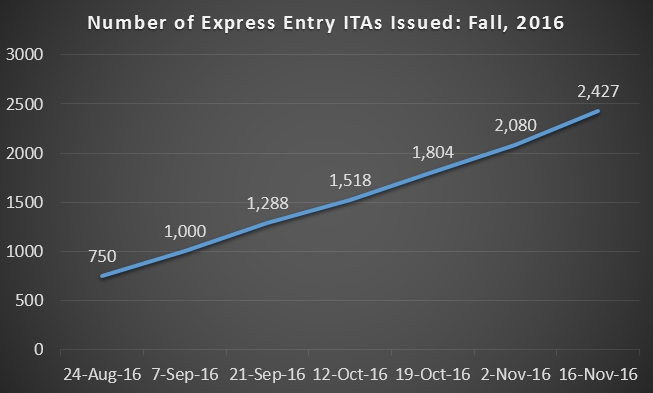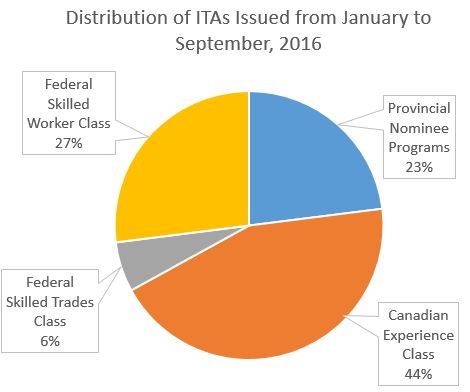Express Entry Exclusive: Human Capital, Skills and Experience to Become More Prominent Under New System
 Immigration, Refugees and Citizenship Canada (IRCC) has provided important new information about the future of the Express Entry selection system. By drawing on the past, IRCC has learned more about its own Express Entry system and made predictions for the future following recent improvements that have been made.
Immigration, Refugees and Citizenship Canada (IRCC) has provided important new information about the future of the Express Entry selection system. By drawing on the past, IRCC has learned more about its own Express Entry system and made predictions for the future following recent improvements that have been made.
For example, over the first year of Express Entry being in operation, 16 percent of all invited candidates were either cooks or food service supervisors, principally because a job offer was previously weighted heavily under the Comprehensive Ranking System (CRS). However, the recent changes to job offers under the CRS, outlined below, aim to allow a more equitable spread of occupations among candidates invited to apply for permanent residence.
The new insights were revealed during the 24th Annual Immigration Law Summit, which takes place this week in Toronto, Ontario. Among the details, it was revealed that around one quarter of all candidates received an Invitation to Apply (ITA) in 2016. And there is more good news for candidates remaining in the pool and individuals thinking of creating a profile — IRCC plans on issuing more ITAs than ever throughout 2017. In doing so, it has stated its renewed goal to put greater weight on human capital, skills and experience.
Qualifying job offers
A job offer was not, and is not, required in order for a candidate to enter the Express Entry pool or receive an ITA.
Until November 19, 2016, candidates with a qualifying job offer supported by a Labour Market Impact Assessment (LMIA) were awarded 600 CRS points. Since the improvements to the Express Entry system came into force on November 19, however, a number of changes to the qualifying job offer factor have been implemented. Notably, a qualifying job offer is now worth 200 points if the offer is in an occupation contained in a Major Group 00 of the National Occupational Classification, or 50 points for a job offer in any other skilled position.
In addition, some non-LMIA-based job offers are now also being awarded points for the first time. These include workers in Canada on a NAFTA work permit or as an Intra-Company transferee. In these non-LMIA cases, the worker must have been working in Canada for at least one year and the job offer must be made by the same employer named on the work permit.
Furthermore, the job offer duration requirement has also changed from ‘indeterminate’ to at least one year in duration.
In a presentation at the Immigration Law Summit, an IRCC representative provided a ‘snapshot’ from the pool as of October 3, 2016. This snapshot revealed that about two-thirds (66 percent) of candidates with qualifying job offers claimed core CRS scores of 300 or less (core CRS indicates a candidate’s score without the additional points awarded for a provincial nomination or a qualifying job offer). Consequently, a majority of job offer candidates had core CRS scores that placed them among the bottom seven percent of candidates in the distribution. And yet, by virtue of having received a qualifying job offer, these candidates were well positioned to obtain an ITA.
As a result, and according to its latest report, IRCC seeks to ‘balance the Comprehensive Ranking System to put greater weight on human capital, skills and experience.’ As such, the CRS has changed to ‘better reflect the empirical value of arranged employment,’ with the expected result that:
- a greater share of invitations will flow to candidates with high levels of human capital, which will improve immigrant economic outcomes and better enable employers to fill high-skilled job openings;
- it will likely change the occupational distribution of invited candidates, with fewer candidates invited with offers of arranged employment in low wage occupations; and
- while a job offer will no longer guarantee an ITA, it does significantly increase the chances of being invited to apply.
CRS threshold may go up before coming down
Although the number of CRS points awarded for a job offer has decreased substantially (in most cases, from 600 points down to 50 points), it should be noted that the number of candidates who may be in a position to claim these points has increased. This is because the requirements surrounding the job offer have been relaxed to include many candidates holding an employer-specific work permit in Canada.
As a result, it may be expected that the CRS cut-off point in the first draw — or first few draws — after the changes have come into force may actually go up temporarily to allow for the fact that more candidates with job offers may claim additional points. Once this initial group of candidates has exited the pool, however, IRCC expects the CRS cut-off point to decrease. Stakeholders should note IRCC’s desired and expected outcome of the recent changes, outlined above, which state that candidates without a job offer are likely to have a better chance of receiving an ITA. From January to September, 2016, 35 percent of ITAs were issued to candidates without a job offer or provincial nomination; IRCC expects this figure to increase over time.
October 3 snapshot of the pool
As of October 3, there had been 20 rounds of invitations (draws) so far in 2016. The snapshot of the pool on that date revealed that:
- There were 60,689 candidates active in the pool.
- A total of 20,588 ITAs had been issued to 19,088 individual candidates over the first 20 draws of 2016. (Note: some candidates may obtain more than one ITA. For example, if they receive an ITA but don’t feel ready to apply, they may re-enter the pool and be issued another ITA at a later date.)
- From January to September, 2016, a total of 25,406 Express Entry candidates or their accompanying family members landed in Canada as permanent residents.
From this glimpse into the pool, it is apparent that around one in every four candidates who was actively engaged in the Express Entry system over the first nine months of 2016 received an ITA. Indeed, there have been four further draws since October 3, and the number of ITAs issued has nearly doubled from 1,288 (September 21 draw) to 2,427 on November 16.

Smoother pathways to permanent residence for students and graduates
One of the most significant changes made to the CRS on November 19 was with respect to international students and graduates in Canada. IRCC’s stated objectives are to increase the number of former international students receiving an ITA and provide additional incentive for foreign nationals to study in Canada. Previously, there were no additional points available to these students, and former international students made up less than 30 percent of all invited candidates. However, points may now be awarded to the principle applicant for Canadian education as follows:
- 15 points, to candidates who have an eligible credential from a one-year or two-year post-secondary program;
- 30 points, to candidates who have an eligible credential from:
- a post-secondary program of three years or more;
- a university-level program at the master’s level or at the level of an entry-to-practice professional degree for an occupation listed in the National Occupational Classification matrix at Skill Level A for which licensing by a provincial regulatory body is required; or
- a university-level program at the doctoral level.
Interestingly, IRCC projects that ‘a reduction of points to candidates with arranged employment means the CRS cut-off will decline, leaving more invitation space for students.'
Leading up the recent changes, Canada’s Minister of Immigration, John McCallum, said that “International students have been shortchanged by the Express Entry system. They are the cream of the crop, in terms of potential future Canadians.” As a result of the changes, IRCC expects that former international students will make up closer to 40 percent of all invited candidates in future draws from the pool.
Provincial Nominee Programs
When IRCC released its year-end report on Express Entry, covering the entirety of 2015, it was revealed that around 13 percent of candidates issued an ITA last year had obtained a provincial nomination certificate through one of the many Provincial Nominee Programs (PNPs) that contain a category aligned with Express Entry.
 Over the first nine months of 2016, however, the percentage of candidates who were invited to apply having obtained a provincial nomination certificate increased to 23 percent of the total, showing the increasing importance of these programs.
Over the first nine months of 2016, however, the percentage of candidates who were invited to apply having obtained a provincial nomination certificate increased to 23 percent of the total, showing the increasing importance of these programs.
Note: candidates must be eligible for one of the three federal economic immigration programs (FSW, FST, CEC) in order to enter the pool.
It should also be noted that candidates who obtain an enhanced nomination certificate through a Provincial Nominee Program (PNP) category will continue to be awarded 600 points, even after the recent changes to the CRS. This makes PNPs by far the single most valuable factor under the new system.
Additionally, the government of Canada plans to welcome around 51,000 new immigrants through the PNPs next year, a seven percent increase on the target for 2016. With Express Entry PNP categories opening and changing over time, it is arguably more important than ever before for candidates to stay up to date on these immigration programs.
Human capital, skills, and experience
“The recent snapshot from the pool is a real eye-opener for many stakeholders, particularly when it comes to the fact that candidates may have a better chance of receiving an ITA than they might have thought previously. The fact that IRCC has stated its intention to invite more candidates based on human capital, skills, and experience is a boon for candidates in the pool,” says Attorney David Cohen.
“The government has added, however, that it is looking to make further changes in 2017. These changes may include additional points for candidates with siblings in Canada or for French-speaking candidates, and it is not possible to tell if or when these changes may occur or how the distribution of points under the system may be affected.
“What we do know at this time is that more people are being invited to apply, that IRCC expects the CRS cut-off to decline over time, and that candidates who are eligible to enter the pool currently may never have a better opportunity to immigrate to Canada.”
A New CRS Calculator is Available
Candidates in the Express Entry pool, as well as individuals thinking of creating an Express Entry profile, can use the new and improved CRS Calculator to find out what their score would be under the new points system.
To find out if you are eligible to immigrate to Canada permanently, fill out a free online assessment form.
© 2016 CICNews All Rights Reserved
- Do you need Canadian immigration assistance? Contact the Contact Cohen Immigration Law firm by completing our form
- Send us your feedback or your non-legal assistance questions by emailing us at media@canadavisa.com






